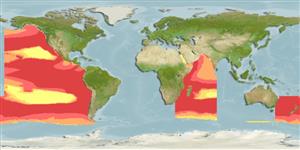>
Beryciformes (Sawbellies) >
Cetomimidae (Flabby whalefishes)
Etymology: Parataeniophorus: Greek, para in the side of + latin, taenia = stripe + Latin, fero = to carry (Ref. 45335).
Environment: milieu / climate zone / depth range / distribution range
Ecologia
marino batipelagico; distribuzione batimetrica 0 - 1400 m (Ref. 58302). Temperate
Western Indian Ocean: has been taken at 24°33'S, 38°26'E and at 21°13'S, 42°26'E. Reported from New South Wales, Australia (Ref. 7300) and California, USA.
Size / Peso / Age
Maturity: Lm ? range ? - ? cm
Max length : 4.6 cm TL maschio/sesso non determinato; (Ref. 6619)
Short description
Chiavi di identificazione | Morfologia | Morfometria
Spine dorsali (totale) : 0; Raggi dorsali molli (totale) : 15 - 20; Spine anali: 0; Raggi anali molli: 14 - 17. Large preserved specimens brownish in color (Ref. 6619). Pectorals with approx. 16-18 soft rays.
Life cycle and mating behavior
Maturities | Riproduzione | Spawnings | Egg(s) | Fecundities | Larve
Bertelsen, E., 1986. Mirapinnidae. p. 406-407. In M.M. Smith and P.C. Heemstra (eds.) Smiths' sea fishes. Springer-Verlag, Berlin. (Ref. 6619)
IUCN Red List Status (Ref. 130435)
Threat to humans
Harmless
Human uses
Strumenti
Special reports
Download XML
Fonti Internet
Estimates based on models
Preferred temperature (Ref.
123201): 6.2 - 15.3, mean 9 °C (based on 410 cells).
Phylogenetic diversity index (Ref.
82804): PD
50 = 0.6250 [Uniqueness, from 0.5 = low to 2.0 = high].
Bayesian length-weight: a=0.00389 (0.00180 - 0.00842), b=3.12 (2.94 - 3.30), in cm total length, based on all LWR estimates for this body shape (Ref.
93245).
Resilienza (Ref.
120179): Alto, tempo minimo di raddoppiamento della popolazione meno di 15 mesi (Preliminary K or Fecundity.).
Fishing Vulnerability (Ref.
59153): Low vulnerability (10 of 100).
